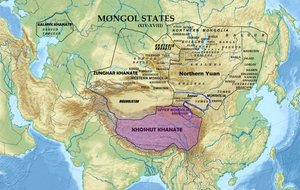Khoshut Khanate ᠬᠣᠱᠤᠳ ᠤᠯᠤᠰ 和碩特汗國 | |||||||||
|---|---|---|---|---|---|---|---|---|---|
| 1642–1717 | |||||||||
 Location of the Khoshut Khanate among Mongol tribes | |||||||||
| Status | Nomadic empire | ||||||||
| Religion | Tibetan Buddhism | ||||||||
| Government | Monarchy | ||||||||
| History | |||||||||
• Established | 1642 | ||||||||
• Disestablished | 1717 | ||||||||
| |||||||||
| Today part of | China | ||||||||
The Khoshut Khanate was a Mongol Oirat khanate based in the Tibetan Plateau from 1642 to 1717. Based in modern Qinghai, it was founded by Güshi Khan in 1642 after defeating the opponents of the Gelug school of Tibetan Buddhism in Tibet. The 5th Dalai Lama established a civil administration known as Ganden Phodrang with the aid of Güshi Khan. The role of the khanate in the affairs of Tibet has been subject to various interpretations. Some sources claim that the Khoshut did not interfere in Tibetan affairs and had a priest and patron relationship between the khan and Dalai Lama while others claim that Güshi appointed a minister, Sonam Rapten, as de facto administrator of civil affairs while the Dalai Lama was only responsible for religious matters. Güshi Khan accepted the nominal suzerainty of the Qing dynasty in 1654, when seal of authority and golden sheets were granted by the Shunzhi Emperor.[1] In the last years of the khanate, Lha-bzang Khan murdered the Tibetan regent and deposed the 6th Dalai Lama in favor of a pretender Dalai Lama.
The Khoshut Khanate was ended in 1717 when the Dzungar prince Tseren Dondup invaded Tibet, killed Lha-bzang Khan, and installed the 7th Dalai Lama.
- ^ 柴达木文史丛书.第4辑.固始汗及其子孙. Beijing Book Co. December 2016. ISBN 978-7-999065-90-6. 皇上勝過締造萬物之如意寶,布仁慈於四海之濱;揚善抑惡,以足眾生之望。蒙天恩賞賜金冊、金印,封為遵行文義慧敏顧實汗,謹望闥跪接祗領,叩謝天恩。The Emperor is better than the wish-fulfilling treasure that created all things, spreading kindness to the shores of the four seas; promoting good and suppressing evil to satisfy the hopes of all living beings. I was rewarded with a gold book and a gold seal by Heaven's grace, and was named Obey Wenyi Huimin Gu Shihan. I sincerely hope that I will kneel down to accept the leader and kowtow to thank Heaven's grace.